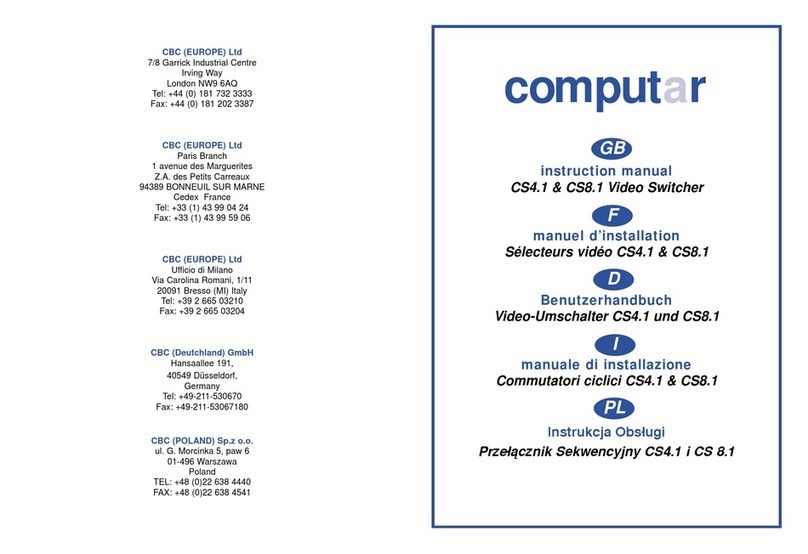48
5 ) Programming the CS16.4PII Remote Switcher
Programming is carried out by connecting a slave selector to the CS 16.4PII remote
switcher via the slave port to be programmed and putting the Program Switch on the remote
switcher from the 'Normal' to the 'Program' position. Refer to the connection diagram in
Section 4.2 for the location of this switch.
It is possible to program which cameras are available to be viewed on each monitor output.
It is also possible to program which of the four slave selector ports can control which of the
four monitor outputs of the switcher. It is recommended that this be programmed first.
5.1) Programming Monitor Availability
The CS 16.4PII is supplied programmed so that Slave Ports 1 & 2 have access to Monitors
A & B only, Slave Ports 3 & 4 have access to Monitors C & D only. Slave-to-Monitor
availability is programmable to be in any combination.
To make a monitor unavailable from a particular port: -
Connect a slave selector to the Slave Port to be programmed.
Put the NORMAL/PROGRAM switch on the remote switcher to PROGRAM.
Press the 'MON' button until the monitor to be made unavailable is selected, as shown by
the ABCD lights next to the 'MON' button.
Press and hold the 'SKIP' button on the slave selector. Camera lights will come on to
indicate which cameras are available to this monitor (and, hence, that the monitor is
available).
With the 'SKIP' button still held, press the 'MON' button. All of the camera lights will go OFF
to indicate that this monitor is now NOT available.
Release the 'SKIP' button.
Press the 'MON' button to select the next monitor to be programmed.
Repeat this for all of the monitor outputs for which access is to be denied to this slave port.
To make a monitor available from a particular port: -
Repeat the process described above, but press the 'MON' button so that the camera lights
come ON to indicate which cameras are available to this monitor ( and, hence, that the
monitor is available).
To program monitor availability from another slave port connect the slave selector to this
port and repeat the above process.
When programming is complete, put the NORMAL/PROGRAM switch to NORMAL to store
the program in non-volatile memory and exit to normal operation.
5
7.4) Urzàdzenie do przed∏u˝ania aktywnego stanu alarmu
Panel prze∏àczania mo˝e byç blokowany w stanie alarmu (poza czas nastawiony na
przekaêniku) przy u˝yciu styku zewn´trznego (np. styku wyjÊcia alarmu VCR) w ten sposób,
˝e wyjÊcie panelu prze∏àczania b´dzie utrzymywane na kamerze w stanie alarmu prze
czasokres dzia∏ania wy∏àcznika alarmu VCR.
Aby to wykonaç, nale˝y pod∏àczyç zewn´trzny styk wyjÊcia alarmu VCR (bez-napi´ciowy)
pomi´dzy wejÊciem 'Alarm Hold' (Podtrzymanie alarmu) i 'Alarm Common' (Wspólny
alarm).
7.5) Automatyczny ruch kamerà do uprzednio ustawionych pozycji, po otrzymaniu
alarmu.
Istnieje mo˝liwoÊç automatycznego wysy∏ania kamery do uprzednio ustawionej pozycji '2'
w przypadku otrzymania sygna∏u alarmu pod warunkiem, ˝e u˝ywany interfejs alarmów z
selektorem CS jest wyposa˝ony w telemetryczny blok klawiaturowy typu 'CS TXP' lub 'CS
TXPJ'. Panel prze∏àczania jest fabrycznie tak ustawiony, ˝e funkcja ta jest niedost´pna
(wy∏àczona).
Aby umo˝liwiç dzia∏anie tej funkcji, nale˝y nacisnàç i przytrzymaç przycisk 'PROGRAM'
(znajdujàcy si´ na telemetrycznym bloku klawiaturowym) i nacisnàç przycisk 'WIPE', aby
zmieniç ustawienie. Gdy 'WIPE' si´ Êwieci, wtedy - w momencie otrzymania alarmu -
kamera przesunie si´ do swojej (uprzednio ustawionej) pozycji '2', a gdy Êwiat∏o 'WIPE' nie
Êwieci si´ to funkcja ruchu kamery jest wy∏àczona.
Zwolniç przycisk 'PROGRAM' w celu zachowania tego ustawienia w pami´ci i powrotu do
normalnego trybu pracy.
Uwaga: Aby mo˝na by∏o zastosowaç tà funkcj´, kamera musi byç wyposa˝ona w
odpowiedni sprz´t sterujàcy; tj. odbiornik telemetryczny 'CS RXP', g∏owic´ do
panoramowania / wychylania w pionie (z mo˝liwoÊcià uprzedniego wprowadzania nastaw
ruchu) oraz odpowiedni obiektyw.
WA˚NE - JeÊli wejÊcia alarmu sà pod∏àczone bezpoÊrednio do odbiornika telemetrycznego
lub gdy urzàdzenie "CS APCB" jest pod∏àczone do przetwornika "CS PCDII Protocol
Converter" w celu przestawiania kamery (lub obudowy) w uprzednio ustawione pozycje,
wtedy ww. funkcja (panelu prze∏àczania) ustawiania kamery w pozycje alarmowe MUSI byç
wy∏àczona. JeÊli tego nie zrobimy to kamera nie b´dzie si´ przemieszczaç do prawid∏owej
(uprzednio ustawionej) pozycji, po otrzymaniu sygna∏u alarmu przez odbiornik
telemetryczny.
8) WyjÊcie przekaênika dodatkowego
Panel prze∏àczania "CS 16.4PII " jest wyposa˝ony w (normalnie otwarte) wyjÊcie
przekaênika dodatkowego, które jest obs∏ugiwane przez przycisk 'AUX' na telemetrycznym
bloku klawiaturowym "CS TXP" lub "CS TXPJ". Jest to przekaênik blokujàcy, wyposa˝ony
we wskaênik Êwietlny (nad swoim przyciskiem na klawiaturze) w celu pokazywania swojego




























